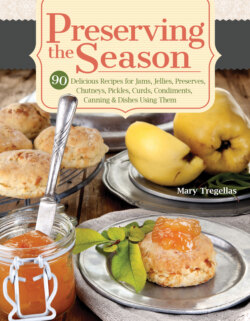Читать книгу Preserving the Season - Mary Tregellas - Страница 8
Useful equipment
ОглавлениеMany preserves can be made with the most basic equipment—a pan, a wooden spoon, and some jars—but there are some other handy tools to have on hand.
Preserving Pan
If you are going to invest in just one thing, then let it be a stainless steel preserving pan (or maslin pan). These are large, deep pans with sloped sides, which allow liquid to reduce more quickly and lessen the danger of hot preserves splashing everywhere. A large, heavy-based stainless steel saucepan is the best alternative. Avoid aluminum pans, which can affect the taste.
Wooden Spoon
One with a long handle is best—hot preserves can spit, so it is a good idea to keep a little distance between them and your hands. Avoid metal spoons, which can react with ingredients and discolor the preserves.
Jam Thermometer
These clip to the side of the pan and are used to prevent over-boiling. They also check the temperature of preserves to ensure that they have reached the correct temperature for setting. I rarely use mine for this, but do find it useful when pasteurizing cordials.
Jam Funnel
This is a special wide-mouthed funnel that makes it much easier to fill jars without spills. A narrow funnel is useful for filling bottles, too. An alternative is to pour the preserve into jars using a heatproof jug.
Jelly Bag and Stand
A fine-woven bag is used to strain the juice from the pulp when making jelly and cordials. Often sold with a stand, or with loops for hanging, they can also be attached to an upturned stool with a bowl underneath to catch the juice. Alternatively, line a large strainer with a double layer of muslin or fine cotton (such as an old, clean dish towel) and suspend over a deep bowl. The jelly bag should always be scalded in a saucepan of boiling water just before use.
Making preserves doesn’t require many tools. A wooden spoon and some pots will easily get the job done.
A jelly bag must be scalded in boiling water before each use.
Muslin or Spice Ball
Use a piece of muslin for tying whole spices together. A spice ball is a metal mesh container, usually on a chain, which clips to the side of the pan (shown opposite).
Slotted Spoon
Scum can form when jams and jellies are cooking, so a slotted spoon is useful for skimming it off the surface. It is also helpful in fishing out stones from cherries, plums, and other stone fruit.
Kitchen Scissors
I find kitchen scissors invaluable in preserve-making, from slicing cooked peel for marmalade and cutting rhubarb into chunks, to chopping chili peppers and dried apricots.
Mouli
Making purées with a stainless steel mouli is a lot easier on the arms than pressing ingredients through a sieve or strainer.
Jars, Bottles, Lids, and Covers
It is fine to reuse jam jars and bottles, as long as they have no chips or cracks, so save them up or ask your friends and neighbors to give you theirs. The most useful sizes are the 12 oz. (340 g) and 8 oz. (227 g) jars. Avoid any that contained very pungent things in a former life.
Lids can also be reused, though with secondhand lids it is advisable to cover the jars with plastic wrap first. Select lids that are not tainted by the smell of the previous preserve—a whiff of gherkin is not great on strawberry jam. For chutneys and pickles, use lids with vinegar-proof linings, as vinegar will corrode metal. You can buy new lids separately, and waxed paper circles, plastic wrap covers, and elastic bands come in packs. Place waxed paper circles (waxed side down) on hot preserves immediately after potting to form a firm seal.
A metal sieve is a good way to spice your preserves without having to worry about any pieces being left behind.
A spiral whisk can also be a handy tool.
A stainless steel mouli will help you strain your preserve mixtures effortlessly.
Mesh spice balls are a great way to add spice flavors to your preserves without having to add the spices directly into your mixtures.
